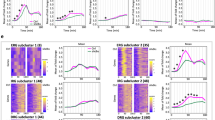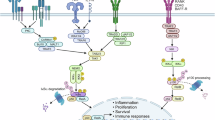Abstract
Although nuclear factor-κB (NF-κB) usually exerts anti-apoptotic activity, upon activation by interleukin-1 (IL-1) it enhances ultraviolet-B radiation (UVB)-induced apoptosis. This paradoxical effect is associated with NF-κB-dependent pronounced secretion of tumour necrosis factor-α (TNF) which activates TNF-R1 in an autocrine fashion to enhance UVB-induced apoptosis. We demonstrate that sustained TNF transcription in UVB+IL-1-treated cells involves complete abrogation of the negative feedback loop of NF-κB preventing IκBα resynthesis, hence allowing uncontrolled NF-κB activity. We show that IκBα is not transcriptionally inhibited but resynthesized protein is immediately marked for degradation due to persistent inhibitor of κB kinaseβ (IKKβ) activity. Continuous IKKβ phosphorylation and activation is caused by UVB-mediated inhibition of the phosphatase PP2A. This study demonstrates that the cellular response to different NF-κB activators may be converted to the opposite reaction when both stimuli act in concert. Our data shed new light on the significance of negative feedback regulation of NF-κB and identifies PP2A as the key regulator of this process.
Similar content being viewed by others
Log in or create a free account to read this content
Gain free access to this article, as well as selected content from this journal and more on nature.com
or
Abbreviations
- UVB:
-
ultraviolet-B light
- TNF:
-
tumour necrosis factor-α
- IL-1:
-
interleukin-1
- NF-κB:
-
nuclear factor-κB
- IκBα:
-
inhibitor of κBα
- IKKβ:
-
inhibitor of κB kinaseβ
References
Li Q, Verma IM . NF-kappaB regulation in the immune system. Nat Rev Immunol 2002; 2: 725–734.
Delhase M, Hayakawa M, Chen Y, Karin M . Positive and negative regulation of IkappaB kinase activity through IKKbeta subunit phosphorylation. Science 1999; 284: 309–313.
Huang TT, Kudo N, Yoshida M, Miyamoto S . A nuclear export signal in the N-terminal regulatory domain of IkappaBalpha controls cytoplasmic localization of inactive NF-kappaB/IkappaBalpha complexes. Proc Natl Acad Sci USA 2000; 97: 1014–1019.
Aggarwal BB . Nuclear factor-kappaB: the enemy within. Cancer Cell 2004; 6: 203–208.
Luque I, Gelinas C . Rel/NF-kappa B and I kappa B factors in oncogenesis. Semin Cancer Biol 1997; 8: 103–111.
Lin A, Karin M . NF-kappaB in cancer: a marked target. Semin Cancer Biol 2003; 13: 107–114.
Kothny-Wilkes G, Kulms D, Luger TA, Kubin M, Schwarz T . Interleukin-1 protects transformed keratinocytes from tumor necrosis factor-related apoptosis-inducing ligand- and CD95-induced apoptosis but not from ultraviolet radiation-induced apoptosis. J Biol Chem 1999; 274: 28916–28921.
Pöppelmann B, Klimmek K, Strozyk E, Voss R, Schwarz T, Kulms D . NFκB-dependent down-regulation of tumor necrosis factor receptor-associated proteins contributes to interleukin-1-mediated enhancement of ultraviolet B-induced apoptosis. J Biol Chem 2005; 280: 15635–15643.
Rocha S, Campbell KJ, Perkins ND . p53- and Mdm2-independent repression of NF-kappa B transactivation by the ARF tumor suppressor. Mol Cell 2003; 12: 15–25.
Campbell KJ, Rocha S, Perkins ND . Active repression of antiapoptotic gene expression by RelA(p65) NF-kappa B. Mol Cell 2004; 13: 853–865.
Rocha S, Garrett MD, Campbell KJ, Schumm K, Perkins ND . Regulation of NF-kappaB and p53 through activation of ATR and Chk1 by the ARF tumour suppressor. EMBO J 2005; 24: 1157–1169.
DiDonato JA, Hayakawa M, Rothwarf DM, Zandi E, Karin M . A cytokine-responsive IkappaB kinase that activates the transcription factor NF-kappaB. Nature 1997; 388: 548–554.
Micheau O, Tschopp J . Induction of TNF receptor I-mediated apoptosis via two sequential signaling complexes. Cell 2003; 114: 181–190.
Schneider-Brachert W, Tchikov V, Neumeyer J, Jakob M, Winoto-Morbach S, Held-Feindt J et al. Compartmentalization of TNF receptor 1 signaling: internalized TNF receptosomes as death signaling vesicles. Immunity 2004; 21: 415–428.
Thoma B, Grell M, Pfizenmaier K, Scheurich P . Identification of a 60-kD tumor necrosis factor (TNF) receptor as the major signal transducing component in TNF responses. J Exp Med 1990; 172: 1019–1023.
Kato Jr T, Delhase M, Hoffmann A, Karin M . CK2 is a C-terminal IkappaB kinase responsible for NF-kappaB activation during the UV response. Mol Cell 2003; 12: 829–839.
Kray AE, Carter RS, Pennington KN, Gomez RJ, Sanders LE, Llanes JM et al. Positive regulation of IkappaB kinase signaling by protein serine/threonine phosphatase 2A. J Biol Chem 2005; 280: 35974–35982.
Yarosh DB, Kripke ML . DNA repair and cytokines in antimutagenesis and anticarcinogenesis. Mutat Res 1996; 350: 255–260.
Kulms D, Schwarz T . 20 years after – milestones in molecular photobiology. J Investig Dermatol Symp Proc 2002; 7: 46–50.
Murphy G, Young AR, Wulf HC, Kulms D, Schwarz T . The molecular determinants of sunburn cell formation. Exp Dermatol 2001; 10: 155–160.
Kupper TS, Ballard DW, Chua AO, McGuire JS, Flood PM, Horowitz MC et al. Human keratinocytes contain mRNA indistinguishable from monocyte interleukin 1 alpha and beta mRNA. Keratinocyte epidermal cell-derived thymocyte-activating factor is identical to interleukin 1. J Exp Med 1986; 164: 2095–2100.
Feldmeyer L, Keller M, Niklaus G, Hohl D, Werner S, Beer HD . The inflammasome mediates UVB-induced activation and secretion of interleukin-1beta by keratinocytes. Curr Biol 2007; 17: 1140–1145.
Kondo S, Sauder DN, Kono T, Galley KA, McKenzie RC . Differential modulation of interleukin-1 alpha (IL-1 alpha) and interleukin-1 beta (IL-1 beta) in human epidermal keratinocytes by UVB. Exp Dermatol 1994; 3: 29–39.
Barker JN, Mitra RS, Griffiths CE, Dixit VM, Nickoloff BJ . Keratinocytes as initiators of inflammation. Lancet 1991; 337: 211–214.
Strozyk E, Pöppelmann B, Schwarz T, Kulms D . Differential effects of NF-kappaB on apoptosis induced by DNA-damaging agents: the type of DNA damage determines the final outcome. Oncogene 2006; 25: 6239–6251.
Aragane Y, Kulms D, Metze D, Wilkes G, Pöppelmann B, Luger TA et al. Ultraviolet light induces apoptosis via direct activation of CD95 (Fas/APO-1) independently of its ligand CD95L. J Cell Biol 1998; 140: 171–182.
Rosette C, Karin M . Ultraviolet light and osmotic stress: activation of the JNK cascade through multiple growth factor and cytokine receptors. Science 1996; 274: 1194–1197.
Huang TT, Feinberg SL, Suryanarayanan S, Miyamoto S . The zinc finger domain of NEMO is selectively required for NF-kappa B activation by UV radiation and topoisomerase inhibitors. Mol Cell Biol 2002; 22: 5813–5825.
Bender K, Gottlicher M, Whiteside S, Rahmsdorf HJ, Herrlich P . Sequential DNA damage-independent and -dependent activation of NF-kappaB by UV. EMBO J 1998; 17: 5170–5181.
Adam E, Quivy V, Bex F, Chariot A, Collette Y, Vanhulle C et al. Potentiation of tumor necrosis factor-induced NF-kappa B activation by deacetylase inhibitors is associated with a delayed cytoplasmic reappearance of I kappa B alpha. Mol Cell Biol 2003; 23: 6200–6209.
Li S, Wang L, Berman MA, Zhang Y, Dorf ME . RNAi screen in mouse astrocytes identifies phosphatases that regulate NF-kappaB signaling. Mol Cell 2006; 24: 497–509.
Sun SC, Maggirwar SB, Harhaj E . Activation of NF-kappa B by phosphatase inhibitors involves the phosphorylation of I kappa B alpha at phosphatase 2A-sensitive sites. J Biol Chem 1995; 270: 18347–18351.
Traenckner EB, Pahl HL, Henkel T, Schmidt KN, Wilk S, Baeuerle PA . Phosphorylation of human I kappa B-alpha on serines 32 and 36 controls I kappa B-alpha proteolysis and NF-kappa B activation in response to diverse stimuli. EMBO J 1995; 14: 2876–2883.
Sung SJ, Walters JA . Stimulation of interleukin-1 alpha and interleukin-1 beta production in human monocytes by protein phosphatase 1 and 2A inhibitors. J Biol Chem 1993; 268: 5802–5809.
Hong S, Wang LC, Gao X, Kuo YL, Liu B, Merling R et al. Heptad repeats regulate protein phosphatase 2a recruitment to I-kappaB kinase gamma/NF-kappaB essential modulator and are targeted by human T-lymphotropic virus type 1 tax. J Biol Chem 2007; 282: 12119–12126.
Palkowitsch L, Leidner J, Ghosh S, Marienfeld RB . The phosphorylation of serine 68 in the IKK-binding domain of NEMO interferes with the structure of the IKK-complex and the TNF-alpha -induced NF-kappa B activity. J Biol Chem 2007; 283: 76–86.
Mumby M . PP2A: unveiling a reluctant tumor suppressor. Cell 2007; 130: 21–24.
Karin M, Yamamoto Y, Wang QM . The IKK NF-kappa B system: a treasure trove for drug development. Nat Rev Drug Discov 2004; 3: 17–26.
Voorhees PM, Dees EC, O’Neil B, Orlowski RZ . The proteasome as a target for cancer therapy. Clin Cancer Res 2003; 9: 6316–6325.
Walczak H, Degli-Esposti MA, Johnson RS, Smolak PJ, Waugh JY, Boiani N et al. TRAIL-R2: a novel apoptosis-mediating receptor for TRAIL. EMBO J 1997; 16: 5386–5397.
Acknowledgements
We are grateful to T Schwarz, University of Kiel, and K Pfizenmaier, University of Stuttgart, for help with the paper. We also thank P Scheurich and A Hausser, University of Stuttgart, for supplying reagents. This work was funded by the German Research Foundation (DFG, KU 1981/1-1).
Author information
Authors and Affiliations
Corresponding author
Additional information
Edited by E Gallagher
Supplementary Information accompanies the paper on Cell Death and Differentiation website (http://www.nature.com/cdd)
Supplementary information
Rights and permissions
About this article
Cite this article
Barisic, S., Strozyk, E., Peters, N. et al. Identification of PP2A as a crucial regulator of the NF-κB feedback loop: its inhibition by UVB turns NF-κB into a pro-apoptotic factor. Cell Death Differ 15, 1681–1690 (2008). https://doi.org/10.1038/cdd.2008.98
Received:
Revised:
Accepted:
Published:
Issue date:
DOI: https://doi.org/10.1038/cdd.2008.98
Keywords
This article is cited by
-
Anti-Apoptotic NF-κB and “Gain of Function” mut p53 in Concert Act Pro-Apoptotic in Response to UVB+IL-1 via Enhanced TNF Production
Journal of Investigative Dermatology (2015)
-
Aquaporin-3-mediated hydrogen peroxide transport is required for NF-κB signalling in keratinocytes and development of psoriasis
Nature Communications (2015)
-
Dendritic Cell Immune Therapy to Break or Induce Tolerance
Current Stem Cell Reports (2015)
-
HSCARG downregulates NF-κB signaling by interacting with USP7 and inhibiting NEMO ubiquitination
Cell Death & Disease (2014)
-
Modeling time delay in the NFκB signaling pathway following low dose IL-1 stimulation
EURASIP Journal on Bioinformatics and Systems Biology (2011)



